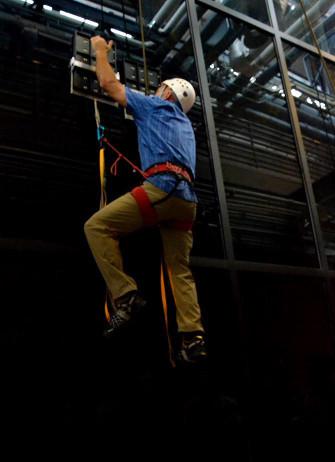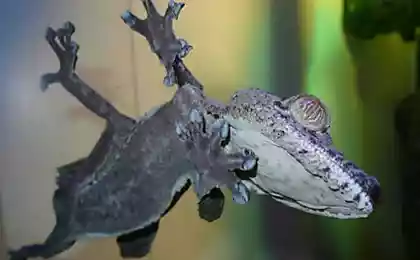2992
The man climbed on 8-meter glass wall with a device that is modeled on the gecko's foot

tropical lizards geckos have the unique structure of the legs, which allows them to run on the walls and ceilings of any material as easily as on the ground. The purpose of the program Z-man agency DARPA - create climbing equipment based on the same principles on which running gecko foot. June 5 DARPA reported on the first major success of this program - a man whose weight with a payload of 122 kg was, up and down the steep wall of glass height of 7, 6 meters. For the military, this technology is valuable in that it significantly extends the capabilities of soldiers, especially in urban combat. In civilian life all the different applications of this "superskotcha" which firmly adheres to any surface and at the same time easy to come off, leaving no trace, it is difficult to even imagine.
Scientists have very long to reveal the secret of geckos. On their legs no glands that produce adhesives or suction cups or claws. They are free to run both rough and smooth surfaces for absolutely. They are easy to keep all of your body weight on one foot. Gecko can stick and otleplyat foot up to 15 times per second.
How does the gecko's foot? Its surface is covered with a plurality of pleats, each of which has a plurality of long bristles thinnest 0, 1 mm, and at the end of each bristle has several hundred taps, each of which ends in a triangular spatula total width of 200 nm. Billions of these spatulas adjacent to the surface on which runs gecko, so close that they begin to act Ван-дер-Ваальсовы force intermolecular attraction. They appear only by close contact and under normal conditions is negligible. The unique structure of the gecko's feet by many orders increases the area of close contact with the surface. Gecko spatula and bristles are arranged so that, pulling them at a certain angle, you can easily pull them from the surface. In other areas, they remain firmly adhered to it.

Attempts to create an artificial analogue of gecko foot taken a long time. Several years ago, was designed robot Stickybot , using this principle. So, in many laboratories around the world are developing & quot; gekkonovy Scotch & quot ;, which can carry very much weight. The complexity of creating mountaineering equipment is that it must simultaneously hold heavy loads (weight of a typical gecko does not exceed 100-200 grams, three orders of magnitude less than the weight climber with a load) and at the same time, unlike tape, withstand many cycles cleaving-otlepleniya without noticeable performance degradation. That such a result was achieved scientists from Cambridge Draper Laboratory, which conducts this development commissioned by DARPA.
Source: habrahabr.ru/post/226217/























